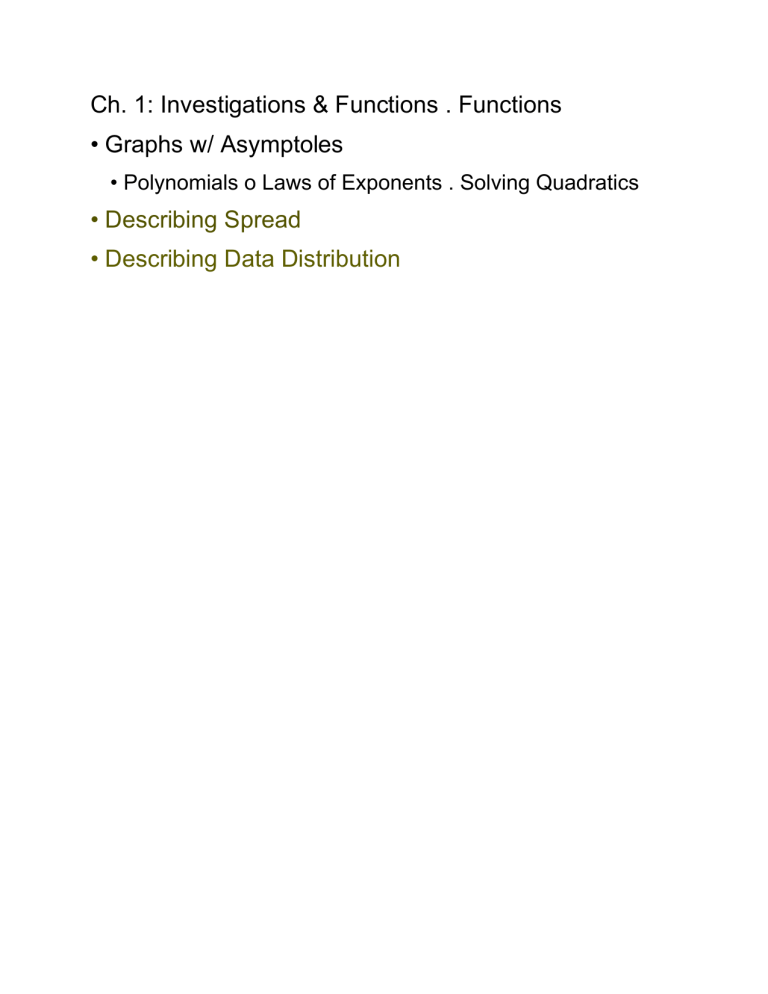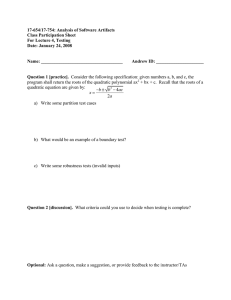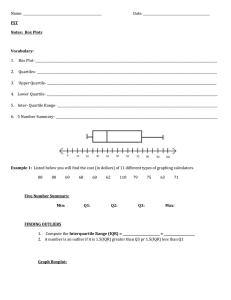Ch. 1 Notes 2018
advertisement

Ch. 1: Investigations & Functions . Functions • Graphs w/ Asymptoles • Polynomials o Laws of Exponents . Solving Quadratics • Describing Spread • Describing Data Distribution Functions, Graphs w/ Asymptotes, Polynomials. Laws of Exponents Functions A relationship between inputs and outputs is a function if there is exactly one output for each input. Functions are often written as y =(some expression involving .x), where x is the input and y is the output. The following equation, table, and graph represent the same function. y =(x - 2)2 ht -2 -1 0 1 2 3 4 5 HAH, 5 st The set of possible input values for a function is called the domain. This set contains every x-value for which the function is defined. The domain of the function above is all real numbers. The range of a function is the set of possible output values. This set contains every y-value that the function can generate. As the graph shows, the minimum value of the function occurs at the vertex, where y = 0. So the range of the function above is y 0 . Another way to write a function is with the notation W/(x) = " instead of 1=57 "y=". The function named "fhas output f(x). The input is x. In the example at right. A5)=9. The input is 5 and the output is 9. You read this as, "fof 5 equals 9." f(x) = (1-2) x2 + y2 = 1 is not a function because there are two y-values (outputs) for some r-values, as shown below. |(5) = 32 + 12 = 1 - y 0110 DT I Graphs with Asymptotes A mathematically clear and complete definition of an asympto calculus, but some examples of graphs with asymptotes should help when they occur. In the following examples, the dotted lines are the equations of the asyimptotes are given. In the two lower grante asymptote. of an asymptote requires some ideas from tes should help you recognize them ted lines are the asymptotes, and the ower graphs, the v-axis, x = 0, is also an #3 y=5 1 x = 2 na ? * asymptotes As you can see in the examples, asymptotes can be diagonal lines or even curves. However, in this course, asymptotes will almost always be horizontal or vertical lines. The graph of a function has a horizontal asymptote if, as you trace along the graph out to the left or right (that is, as you choose x-values farther and farther away from zero, either toward negative infinity or toward positive infinity), the distance between the graph of the function and the asymptote gets smaller and smaller. A graph has a vertical asymptote if, as you choose .r-coordinates closer and close to certain value, from either the left or right (or both), the p-coordinate gets farther away zero. either toward infinity or toward negative infinity. rom Polynomials A polynomial expression in one variable is an expression that can be written as the sum or difference of terms of the form: (any real number)x(whole number) Polynomials in one variable (often .x) are usually arranged with powers of x in order, starting with the highest, from left to right. The highest power of the variable in a polynomial in one variable is called the degree of the polynomial. The numbers that are multiplied by the variable in each term are called coefficients. These descriptions also apply to functions defined by polynomial expressions. See the examples below. Example 1: 3r + 5 is a polynomial of degree 1 with coefficients 3 and 5. Note that the last term, 5, is called the constant term but represents the expression 5.ro. since.ro = 1. The related linear function 1: = 3x + 5 is a polynomial function of degree 1. Example 2: 77% +2.5m2 - 4x + 7 is a polynomial of degree 5 with coefficients 7, 0,2.5.0. - 1. and 7. Example 3: 2(x + 2)(x + 5) is a polynomial in factored form with degree 2 because it can be written in standard form as 2x2 + 14x + 20. The standard form has coefficients 2. 14. and 20. The related quadratic function f(x) = 2x2 + 14.2 + 20 is a polynomial function of degree 2. Laws of Exponents In the expression r. r is the base and 3 is the exponent. Here are the laws of exponents with examples: Law Examples x x = x+for all x hty = xm- for *#0 *-*** = * *4 = ? 0 +* = 410-4 = x6 (x) = xm for all.x = x+3 72 28.2-1 = 24 = 5-} (10') = 10 90 = 1 3-1 = } 8273 - 182 - 164 = 4 x0=1 for x70 *"- for x#0 -2xmin - "x" for n #0 -4/5 - Vx+ Solving Quadratics, Describing Spread, Describing Data Distribution Solving a Quadratic Equation In a previous course, you learned how to solve quadratic equations (equations that can be written in the form ar? + bx+c=0). Review two methods for solving quadratic equations below. Some quadratic equations can be solved by factoring and then using thie Zero Product Property. For example, the quadratic equation r2 – 3r - 10 = 0 can be rewritten by factoring as (x5)(x + 2) = 0. The Zero Product Property states that if ab = 0. then a=0 or b=0. So if (x - 5)(x + 2) = 0. then (x - 5) = 0) or (r + 2) = 0. Therefore, r = 5 ory=-2. Another method for solving quadratic equations is using the Quadratic Formula. This method is useful for solving quadratic equations that are difficult or impossible to factor. Before using the Quadratic Formula, shown below, the quadratic equation you want to solve must be in standard forin (that is, written as ar? + hr+c=0). . ax #bX+1:0, - bV62 - 4ac 2a The Quadratic Formula gives two possible solutions for r. The two solutions are shown by the "3" symbol. This symbol (read as "plus or minus”) is shorthand notation that tells you to evaluate the expression twice: once using addition and once using subtraction. Therefore, Quadratic Formula problems usually must be simplified twice to give: I=. _ -b + Vb2 - 4ac Le 2a or r= -- Vb2 - 400 2a To solve r- - 3x - 10 = 0 using the Quadratic Formula, substitute a= 1, b = -3, and c=-10 into the formula, as shown below, then simplify. X- 201) -(-3)+/(-3)2-4(1)(-10) 2(1) r = 31749 t = or 근 x= 5 or -2 forens Completing the square: x?+ 4x + 10 =0 x?+4x4 =-10+4 (x+2) = -6 X+2 = +ive X = -2* i Ja Describing Spread A distribution of single-variable data can be summarized by describing its center, shape. spread awa outliers. Three ways to describe spread are explained below. Range : max-min Range The range is the maximum minus the minimum. It is usually not a good way to describe the sprea because it considers only the extreme values in the data, rather than how the bulk of the data is spread. For the data set below, the range is 30 - 11 = 19. 11,13,15,19 22,22,25,26,27,28,29) 29,30 min Q1 = 17 median Q3 = 28.5 max Interquartile Range (IQR) Q The variability, or spread, in the distribution can be numerically summarized with the interquartile range (IQR). The IQR is found by subtracting the first quartile (Q1) from the third quartile (03). The IQR is the range of the middle half of the data. IQR can represent the spread of any data distribution, even if the distribution is not symmetric or has outliers. In the data set above, the IOR is Q3 - Q1 = 28.5 - 17 = 11.5. Interquartile Range (IQR) The variability, or spread, in the distribution can be mumerically summarized with the interquartile range (IQR). The IQR is found by subtracting the first quartile (QI) from the third quartile (Q3). The IQR is the range of the middle half of the data. IQR can represent the spread of any data distribution, even if the distribution is not symmetric or has outliers. In the data set above, the IQR is Q3 - Q1 = 28.5 - 17 = 11.5. Standard Deviation Either the interquartile range or standard deviation can be used to represent the spread if the data is svinmetric and has no outliers. The population standard deviation is the square root of the average of the distances to the mean, after the distances have been made positive by squaring. For the data set above: • There are 13 values in the population and the mean value is about 22.77. • The sum of the squares of the distances from the mean is (-11.77)2 + (-9.77)2 + (-7.77)2 + (-3.77)2 + (-0.77)2+(-0.77)2 + 2.232 + 3.232 + 4.232 + 5.232 +6.232 – 500.3 • The population standard deviation i 500 6.2 Because gathering data for entire populations is often impractical, most of the data sets we analyze are samples. To calculate the sample standard deviation, divide by one less than the number of values in the data set. If the data set above is a sample from a larger population, then the sample standard deviation is 1.500.3 6.5 . Describing a Data Distribution Combination Histogram and Boxplot Single-variable numerical data can be represented graphically with a combination histogram and boxplot. When describing single-variable data, consider the: • Center: mean or median • Shape: symmetric, skewed, single- or double-peaked. uniforin He 100 2002 300 Woo IMI muh mh mm Symumetrie skewed (left) single peaked cluble-Paked unitorin • Spread: standard deviation or interquartile range • Outliers: data that is far from the bulk of the data Shape Outlier Center Spread




